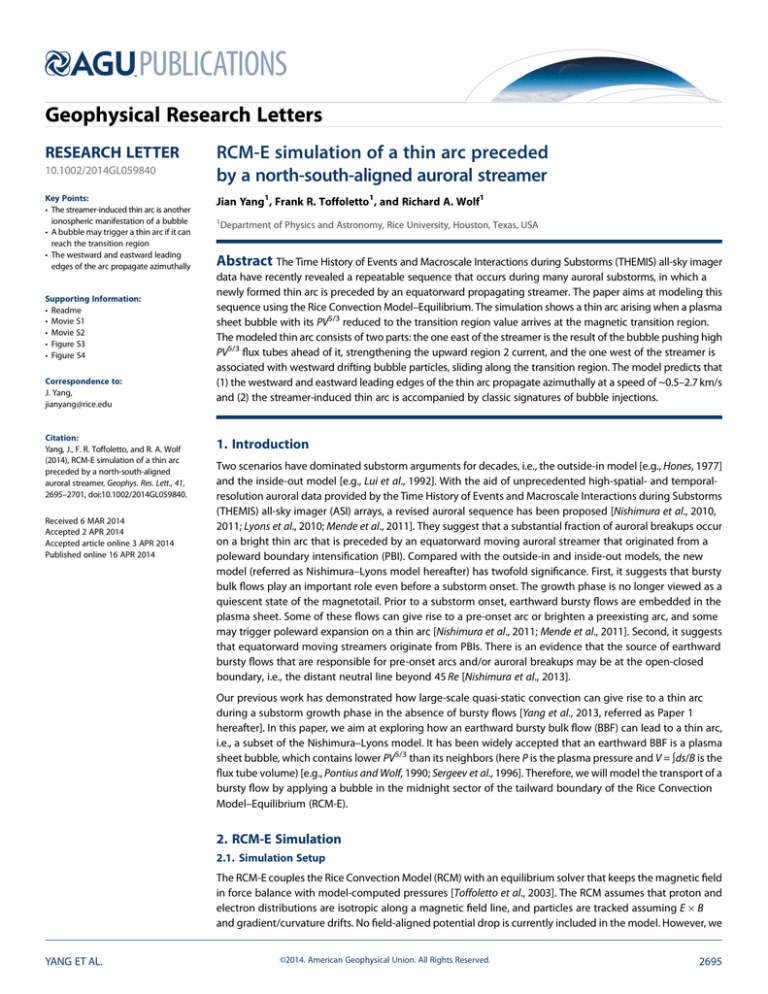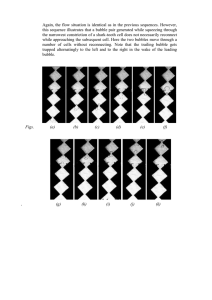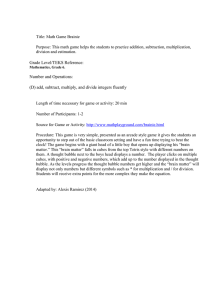
PUBLICATIONS
Geophysical Research Letters
RESEARCH LETTER
10.1002/2014GL059840
Key Points:
• The streamer-induced thin arc is another
ionospheric manifestation of a bubble
• A bubble may trigger a thin arc if it can
reach the transition region
• The westward and eastward leading
edges of the arc propagate azimuthally
Supporting Information:
• Readme
• Movie S1
• Movie S2
• Figure S3
• Figure S4
Correspondence to:
J. Yang,
jianyang@rice.edu
Citation:
Yang, J., F. R. Toffoletto, and R. A. Wolf
(2014), RCM-E simulation of a thin arc
preceded by a north-south-aligned
auroral streamer, Geophys. Res. Lett., 41,
2695–2701, doi:10.1002/2014GL059840.
Received 6 MAR 2014
Accepted 2 APR 2014
Accepted article online 3 APR 2014
Published online 16 APR 2014
RCM-E simulation of a thin arc preceded
by a north-south-aligned auroral streamer
Jian Yang1, Frank R. Toffoletto1, and Richard A. Wolf1
1
Department of Physics and Astronomy, Rice University, Houston, Texas, USA
Abstract The Time History of Events and Macroscale Interactions during Substorms (THEMIS) all-sky imager
data have recently revealed a repeatable sequence that occurs during many auroral substorms, in which a
newly formed thin arc is preceded by an equatorward propagating streamer. The paper aims at modeling this
sequence using the Rice Convection Model–Equilibrium. The simulation shows a thin arc arising when a plasma
sheet bubble with its PV5/3 reduced to the transition region value arrives at the magnetic transition region.
The modeled thin arc consists of two parts: the one east of the streamer is the result of the bubble pushing high
PV5/3 flux tubes ahead of it, strengthening the upward region 2 current, and the one west of the streamer is
associated with westward drifting bubble particles, sliding along the transition region. The model predicts that
(1) the westward and eastward leading edges of the thin arc propagate azimuthally at a speed of ~0.5–2.7 km/s
and (2) the streamer-induced thin arc is accompanied by classic signatures of bubble injections.
1. Introduction
Two scenarios have dominated substorm arguments for decades, i.e., the outside-in model [e.g., Hones, 1977]
and the inside-out model [e.g., Lui et al., 1992]. With the aid of unprecedented high-spatial- and temporalresolution auroral data provided by the Time History of Events and Macroscale Interactions during Substorms
(THEMIS) all-sky imager (ASI) arrays, a revised auroral sequence has been proposed [Nishimura et al., 2010,
2011; Lyons et al., 2010; Mende et al., 2011]. They suggest that a substantial fraction of auroral breakups occur
on a bright thin arc that is preceded by an equatorward moving auroral streamer that originated from a
poleward boundary intensification (PBI). Compared with the outside-in and inside-out models, the new
model (referred as Nishimura–Lyons model hereafter) has twofold significance. First, it suggests that bursty
bulk flows play an important role even before a substorm onset. The growth phase is no longer viewed as a
quiescent state of the magnetotail. Prior to a substorm onset, earthward bursty flows are embedded in the
plasma sheet. Some of these flows can give rise to a pre-onset arc or brighten a preexisting arc, and some
may trigger poleward expansion on a thin arc [Nishimura et al., 2011; Mende et al., 2011]. Second, it suggests
that equatorward moving streamers originate from PBIs. There is an evidence that the source of earthward
bursty flows that are responsible for pre-onset arcs and/or auroral breakups may be at the open-closed
boundary, i.e., the distant neutral line beyond 45 Re [Nishimura et al., 2013].
Our previous work has demonstrated how large-scale quasi-static convection can give rise to a thin arc
during a substorm growth phase in the absence of bursty flows [Yang et al., 2013, referred as Paper 1
hereafter]. In this paper, we aim at exploring how an earthward bursty bulk flow (BBF) can lead to a thin arc,
i.e., a subset of the Nishimura–Lyons model. It has been widely accepted that an earthward BBF is a plasma
sheet bubble, which contains lower PV5/3 than its neighbors (here P is the plasma pressure and V = ∫ds/B is the
flux tube volume) [e.g., Pontius and Wolf, 1990; Sergeev et al., 1996]. Therefore, we will model the transport of a
bursty flow by applying a bubble in the midnight sector of the tailward boundary of the Rice Convection
Model–Equilibrium (RCM-E).
2. RCM-E Simulation
2.1. Simulation Setup
The RCM-E couples the Rice Convection Model (RCM) with an equilibrium solver that keeps the magnetic field
in force balance with model-computed pressures [Toffoletto et al., 2003]. The RCM assumes that proton and
electron distributions are isotropic along a magnetic field line, and particles are tracked assuming E B
and gradient/curvature drifts. No field-aligned potential drop is currently included in the model. However, we
YANG ET AL.
©2014. American Geophysical Union. All Rights Reserved.
2695
Geophysical Research Letters
10.1002/2014GL059840
Figure 1. Ionospheric view of (left) modified electron precipitation energy flux f en in the units of erg/cm /s, (middle) FAC density with blue being upward and red
5/3
5/3
being downward, and (right) PV in the units of nPa(Re/nT) .
2
have developed a postprocessing procedure to calculate synthetic aurora on the assumption that the
electron auroral energy flux (f en ) is proportional to the sum of the diffuse auroral contribution and a second
term that is proportional to the upward field-aligned current (FAC) above a threshold [Yang et al., 2012,
equation (1)]. The high grid resolution and the initial conditions used in RCM-E are the same as in Paper 1.
We designed a three-stage idealized event. In the first stage, we simulate a 60 min long substormgrowth-phase-like interval using a 30 kV polar cap potential drop and an average PV5/3 of ~0.16 nPa(Re/nT)5/3
on the midnight high-latitude boundary. The overall convection is deliberately designed to be weaker than that
in Paper 1, so that the suggested mechanism for thin arc formation in Paper 1 does not operate. (Note that the
growth-phase-arc-like synthetic aurora in the post-midnight sector seen at T = 60 min in Movies S1 and S2 in
the supporting information is associated with an upward region 2 FAC. Because of our crude way in modifying
the precipitating energy flux, the synthetic aurora will be particularly bright wherever the upward FAC is
substantial.) In the second stage, we apply a bubble injection through the tailward boundary for 10 min. The
bubble, which is assumed to be centered at midnight, has a width of 0.5 h in local time on the boundary. PV5/3
inside the bubble is reduced to two thirds of that in the pre-bubble injection time. The potential drop inside
the bubble is set to be ~24 kV, significantly enhanced from ~4 kV for the same range of local time in the
pre-injection time. In the third stage, which started at T = 70 min, the PV5/3 and electric potential distributions
are set equal to those in the first stage. The magnetic field is reequilibriated every 5 min in the first stage and
every 1 min in the second and third stages.
2.2. Results
Figure 1 shows the overview sequence of bubble injection in the ionosphere. A bright streamer first appears
from the high-latitude boundary along the westward edge of the bubble. As the bubble moves earthward
inside 10 Re, the region 2 FAC ahead of the bubble is enhanced (Movie S1 in the supporting information), as
suggested by Yang et al. [2012]. The bubble does not penetrate deep inside geosynchronous orbit. Instead,
when it reaches the inner edge of the plasma sheet where PV5/3 decreases from more than 0.16 to less than
YANG ET AL.
©2014. American Geophysical Union. All Rights Reserved.
2696
Geophysical Research Letters
10.1002/2014GL059840
(a)
(b)
(c)
(d)
(e)
(f)
Figure 2. (left) FAC density mapped to the equatorial plane with blue (negative) being upward, (middle) PV
pressure. The black lines are V contours every 0.02 Re/nT.
5/3
5/3
in the units of nPa(Re/nT)
, and (right) plasma
0.08 nPa(Re/nT)5/3 at 7~10 Re, the bubble tends to drift westward. Within 1~2 min, a very thin arc starts to
emerge roughly at the same location in the pre-midnight sector. The full width at half maximum of the
modified energy flux at magnetic local time (MLT) = 22.5 is only about 16 km at T = 01:18. Movie S1 in the
supporting information also indicates that the pre-midnight arc continues to move equatorward. A thin arc
also appears in the post-midnight sector within 1~2 min, which is associated with the high PV5/3 flux tubes
pushed ahead of the eastside of the bubble.
Figure 2 shows how the upward (blue) FACs are generated in association with pressure and PV5/3 gradients.
When the bubble is traveling in the plasma sheet (Figure 2, top), earthward E B drift is dominant. The streamer
maps to the westward edge of the bubble. When it reaches the transition region, the bubble becomes more
azimuthally elongated along the deformed inner edge of the plasma sheet. The arc-associated upward FAC
flows just poleward of the main region 2 downward FAC in the pre-midnight sector and is related to the
eastward decrease of PV5/3. In the post-midnight sector, the arc-associated upward FAC is the enhanced
region 2 FAC. It is related to the flux tubes intruding earthward with higher PV5/3 than that the existed prior to
the bubble injection time. In the plasma distribution, the increased upward FACs and the arcs are associated
with the earthward (tailward) part of a local plasma pressure ridge in the post-midnight (pre-midnight) sector at
r ≈ 7~8 Re, which is induced by the bubble injection [Yang et al., 2011].
Figure 3 (left) shows keogram-like plots of f en. It is clear that (1) both the pre-midnight and post-midnight arcs
form equatorward of the streamer and (2) the longitudinal extensions of both arcs are wider than the
streamer; (3) both arcs move equatorward but at a much slower rate than the streamer. Figure 3 (right) shows
the MLT-time map of f en, averaged between 64° and 66° latitude, where the arc is located. It indicates that
after the bubble reaches 66° latitude at T = 67 min, the westward leading edge of the arc propagates
YANG ET AL.
©2014. American Geophysical Union. All Rights Reserved.
2697
Geophysical Research Letters
(a)
10.1002/2014GL059840
(d)
(b)
(c)
Figure 3. (a–c) Time-latitude map of f en in the units of erg/cm /s at three MLTs. (d) MLT-time map of f en , averaged between 64° and 66° latitude.
2
(a)
(b)
(c)
Figure 4. (a) FAC density, (b) ionospheric E B drift velocity, and (c)
proton differential fluxes at a fixed location in the ionosphere.
YANG ET AL.
©2014. American Geophysical Union. All Rights Reserved.
westward at an average speed of
~2.7 km/s in the following 5 min and
then at a slower speed of ~0.5 km/s,
while the eastward leading edge of the
arc propagates eastward at an average
speed of ~0.8 km/s.
We shall pay more attention to the
pre-midnight arc, since a pre-onset arc is
known as more frequently observed in
that sector than in the post-midnight.
Figure 4 shows the FAC and bubble
injection signatures at a fixed point to
the west and equatorward of the
streamer in the ionosphere. The FAC first
exhibits a sharp peak in the downward
direction before turning into an upward
current. The calculated equatorward
E B velocity at the center of the bubble
is ~500 m/s in the ionosphere, roughly
consistent with the observations of Shi
et al. [2012]. The northward drift velocity
in Figure 4b is the return flow on the
westward edge of the bubble at
MLT = 22.5 h, which is accompanied with
a strongly enhanced westward drift
primarily on the equatorward edge of
the bubble. The arc is also associated
2698
Geophysical Research Letters
10.1002/2014GL059840
(a)
with typical particle injection signatures at
equatorial points that map to that fixed
point in the ionosphere (Figure 4c).
3. Discussion
It is widely accepted that a N-S-aligned
streamer in the auroral zone is the
ionospheric footprint of the westward
edge of a bubble, along which upward FAC
is flowing (Figure 5a) [e.g., Nakamura et al.,
2001]. When a bubble is traveling through
the middle plasma sheet, earthward
(b)
charge- and energy-independent E B
drift is dominant, making the bubble
elongated roughly in the Sun-Earth
direction. Thus, contributions to FACs from
ions with different λ values are nearly
colocated in the middle plasma sheet
(Figure S3 in the supporting information).
(Here the energy invariant λ is given by
WKV2/3, where WK is the kinetic energy.)
However, when the bubble arrives at the
transition region, azimuthal gradient/
curvature drifts become dominant,
stretching the bubble in east-west
direction (Figure 5b). Because of the
energy dependence of those drifts, the
Figure 5. Cartoon of a bubble injection, an auroral streamer and thin arcs.
bubble cannot preserve the sharpness of
its depletion boundary: higher-energy ions have stronger westward drift velocities, placing the westward
edges of their depleted regions farther westward (Figures S4d–S4f in the supporting information). Thus,
partial FACs associated with larger-energy invariant ions are shifted westward compared to smaller energy
invariant ions (Figures S4a–S4c in the supporting information). Our calculation also shows that the flux
tube average drift velocities for ions ( E B2 B jqjnPiVB2 B ∇V ) and for electrons ( E B2 B þ jqjnPeVB2 B ∇V ) in
i
e
the ionospheric footprint of the arc are about 0.5~2.5 km/s in the westward direction and 0.5 km/s in the
eastward direction, respectively, consistent with the azimuthal propagation speed of the arc in the
ionosphere (Figure 3d).
Therefore, our simulation suggests that the streamer and the subsequent arc are two ionospheric
manifestations of a depleted bubble. The streamer is associated with the westward edge of the bubble when
it is moving earthward in the plasma sheet, while the subsequent thin arc is associated with the disruption of
the PV5/3 profile near the plasma sheet inner edge by the bubble when it arrives at the magnetic transition
region. It implies that this mechanism for making a thin arc may only work under the circumstance that the
bubble can reach the magnetic transition region. Theoretically, if the inertial effects, such as overshoot and
bouncing, are negligible [Wolf et al., 2012], only those bubbles which have their PV5/3 in the range of
transition region values or below that range can be injected at the transition region. After the earthward
injection, their subsequent motion will be mainly in the azimuthal direction dominated by energy-dependent
gradient/curvature drifts.
The mechanisms described in Paper 1 and in this paper have distinct differences. A thin arc appears gradually
as a result of quasi-static enhanced convection in Paper 1. That mechanism probably cannot operate if the
convection is not strong enough to make a highly stretched configuration of the tail magnetic field. In this
paper, a thin arc forms when a bubble hits the transition region, a more transient process accompanied with
particle injection signatures. A relevant peculiar feature is the rapid azimuthal propagation of the arc’s
leading edges, which is not seen in Paper 1. Although we intentionally modeled the streamer-arc mechanism
YANG ET AL.
©2014. American Geophysical Union. All Rights Reserved.
2699
Geophysical Research Letters
10.1002/2014GL059840
under a relatively weak convection interval, there is no reason to exclude the possibility that this mechanism
can also make an arc under strong convection intervals.
The modeled features described in Paper 1 and in this paper also have similarities. When a thin arc forms, the
FACs in both mechanisms have a double-sheet structure, with an additional region 1 sense FAC immediately
poleward of the main region 2 FAC. The modeled thin arc consists of both east and west parts, with a very
small gap in between and with the east part at slightly lower latitude.
This paper is a report on an initial attempt to model the streamer-arc auroral sequence. Nishimura et al. [2011]
and Mende et al. [2011] have shown that a streamer may (1) intensify the brightness of a preexisting arc, (2)
induce another thin arc separated from the preexisting arc, or (3) lead to an entirely new thin arc in the
background without a preexisting arc. In order to keep the physical picture simple, we only modeled the third
category by purposely designing a situation without a preexisting arc before the introduction of a streamer.
However, future efforts will be needed to investigate whether our mechanism can also be applied to the
situations that include a preexisting arc (e.g., the first and second categories). Meanwhile, we need to carry
out more systematic studies in at least two areas. First, since PV5/3 controls the injection depth of a bubble, we
plan to study how the formation of the thin arc is affected by preconditioning of the background that the
bubble is traveling through and by the degree of depletion inside the bubble. Second, since the gradient/
curvature drifts control the deformation of the bubble in the transition region, we will also investigate the
effects of plasma temperature both in the background and inside the bubble.
In addition, we need to improve our simulation of synthetic aurora by modeling FACs to a more realistic
degree and including the field-aligned potential drops. For example, the arc-like auroral structures in the
post-midnight and dawnside seen at T = 60 min in Movie S1 in the supporting information are very bright,
which did not appear to be consistent with the average auroral morphology in the substorm growth phase.
We believe that there are two reasons for the unrealistic bright aurora. (1) The RCM-E produces unrealistically
strong and thin upward FACs in the post-midnight sector. Erickson et al. [1991] found that depleting the
dawnside plasma sheet outer boundary, which was not done in this simulation, could thicken the upward
region 2 FACs on the dawn side, which would likely result in no arc-like structure. (2) The RCM-E does not
include the effects of low-energy electron component in computing the field-aligned potential drops. We
expect that if we can properly include the effect of these electrons, then the dawnside upward FACs will be
less likely result in field-aligned acceleration, because mirror points of low-energy electrons can easily be
moved down into the atmosphere [e.g., Mende et al., 2003].
We also need to include the inertial effects. It is possible that arcs are generated by inertial effects such as the
Kelvin–Helmholtz instability. These effects are currently not included in the RCM-E. However, our view is that
in the nightside inner plasma sheet, where flows are very subsonic during substorm growth phase, largevelocity shears result from steep gradients in PV5/3 that impact ionosphere-magnetosphere coupling through
the Vasyliunas equation. These steep gradients in PV5/3 are the primary source of the main auroral structures
that result in strong velocity shears, in which inertial effects become important through Kelvin–Helmholtz
instability and auroral curls, etc. [e.g., Vogt et al., 1999].
Acknowledgments
Jian Yang would like to thank Toshi
Nishimura and Larry Lyons for their
helpful discussions. The work was
supported by the NASA Heliophysics
Theory grant NNX11AJ38G, the NASA
Guest Investigator grant NNX10AQ43G,
and the NASA LWS TR&T NNX13AF92G.
The Editor thanks Victor Sergeev and an
anonymous reviewer for their assistance
in evaluating this paper.
YANG ET AL.
References
Erickson, G. M., R. W. Spiro, and R. A. Wolf (1991), The physics of the Harang discontinuity, J. Geophys. Res., 96(A2), 1633–1645, doi:10.1029/
90JA02344.
Hones, E. W., Jr. (1977), Comments on “On hot, tenuous plasmas, fireballs, and boundary layers in the Earth’s magnetotail,” by L. A. Frank, K. L.
Ackerson, and R. P. Lepping, J. Geophys. Res., 82, 5633–5640, doi:10.1029/JA082i035p05633.
Lui, A. T. Y., R. E. Lopez, B. J. Anderson, K. Takahashi, L. J. Zanetti, R. W. McEntire, T. A. Potemra, D. M. Klumpar, E. M. Greene, and R. Strangeway
(1992), Current disruptions in the near-earth neutral sheet region, J. Geophys. Res., 97, 1461–1480, doi:10.1029/91JA02401.
Lyons, L. R., Y. Nishimura, Y. Shi, S. Zou, H.-J. Kim, V. Angelopoulos, C. Heinselman, M. J. Nicolls, and K.-H. Fornacon (2010), Substorm triggering
by new plasma intrusion: Incoherent-scatter radar observations, J. Geophys. Res., 115, A07223, doi:10.1029/2009JA015168.
Mende, S. B., C. W. Carlson, H. U. Frey, L. M. Peticolas, and N. Østgaard (2003), FAST and IMAGE-FUV observations of a substorm onset,
J. Geophys. Res., 108(A9), 1344, doi:10.1029/2002JA009787.
Mende, S. B., H. U. Frey, V. Angelopoulos, and Y. Nishimura (2011), Substorm triggering by poleward boundary intensification and related
equatorward propagation, J. Geophys. Res., 116, A00I31, doi:10.1029/2010JA015733.
Nakamura, R., W. Baumjohann, R. Schödel, M. Brittnacher, V. A. Sergeev, M. Kubyshkina, T. Mukai, and K. Liou (2001), Earthward flow bursts,
auroral streamers, and small expansions, J. Geophys. Res., 106, 10,791–10,802, doi:10.1029/2000JA000306.
Nishimura, Y., L. Lyons, S. Zou, V. Angelopoulos, and S. Mende (2010), Substorm triggering by new plasma intrusion: THEMIS all-sky imager
observations, J. Geophys. Res., 115, A07222, doi:10.1029/2009JA015166.
©2014. American Geophysical Union. All Rights Reserved.
2700
Geophysical Research Letters
10.1002/2014GL059840
Nishimura, Y., L. R. Lyons, V. Angelopoulos, T. Kikuchi, S. Zou, and S. B. Mende (2011), Relations between multiple auroral streamers, pre-onset
thin arc formation, and substorm auroral onset, J. Geophys. Res., 116, A09214, doi:10.1029/2011JA016768.
Nishimura, Y., L. R. Lyons, X. Xing, V. Angelopoulos, E. F. Donovan, S. B. Mende, J. W. Bonnell, and U. Auster (2013), Tail reconnection region
versus auroral activity inferred from conjugate ARTEMIS plasma sheet flow and auroral observations, J. Geophys. Res. Space Physics, 118,
5758–5766, doi:10.1002/jgra.50549.
Pontius, D. H., Jr., and R. A. Wolf (1990), Transient flux tubes in the terrestrial magnetosphere, Geophys. Res. Lett., 17, 49–52, doi:10.1029/
GL017i001p00049.
Sergeev, V. A., V. Angelopoulos, J. T. Gosling, C. A. Cattell, and C. T. Russell (1996), Detection of localized, plasma-depleted flux tubes or
bubbles in the midtail plasma sheet, J. Geophys. Res., 101, 10,817–10,826, doi:10.1029/96JA00460.
Shi, Y., E. Zesta, L. R. Lyons, J. Yang, A. Boudouridis, Y. S. Ge, J. M. Ruohoniemi, and S. Mende (2012), Two-dimensional ionospheric flow pattern
associated with auroral streamers, J. Geophys. Res., 117, A02208, doi:10.1029/2011JA017110.
Toffoletto, F. R., S. Sazykin, R. Spiro, and R. Wolf (2003), Inner magnetospheric modeling with the Rice Convection Model, Space Sci. Rev., 107,
175–196, doi:10.1023/A:1025532008047.
Vogt, J., H. U. Frey, G. Haerendel, H. Höfner, and J. L. Semeter (1999), Shear velocity profiles associated with auroral curls, J. Geophys. Res., 104,
17,277–17,288, doi:10.1029/1999JA900148.
Wolf, R. A., C. X. Chen, and F. R. Toffoletto (2012), Thin filament simulations for Earth’s plasma sheet: Tests of validity of the quasi-static
convection approximation, J. Geophys. Res., 117 A02216, doi: 10.1029/2011JA016972.
Yang, J., F. R. Toffoletto, R. A. Wolf, and S. Sazykin (2011), RCM-E simulation of ion acceleration during an idealized plasma sheet bubble
injection, J. Geophys. Res., 116, A05207, doi:10.1029/2010JA016346.
Yang, J., F. R. Toffoletto, R. A. Wolf, S. Sazykin, P. A. Ontiveros, and J. M. Weyg (2012), Large-scale current systems and ground magnetic
disturbance during deep substorm injections, J. Geophys. Res., 117, A04223, doi:10.1029/2011JA017415.
Yang, J., R. A. Wolf, F. R. Toffoletto, and S. Sazykin (2013), RCM-E simulation of substorm growth phase arc associated with large-scale
adiabatic convection, Geophys. Res. Lett., 40, 6017–6022, doi:10.1002/2013GL058253.
YANG ET AL.
©2014. American Geophysical Union. All Rights Reserved.
2701





